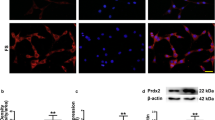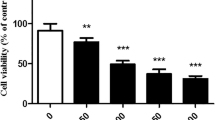Abstract
Heme oxygenase-1 (HO-1) catalyses the rate-limiting step of heme degradation to biliverdin, which is in turn reduced to bilirubin, CO and free iron. HO-1 can be induced by several harmful stimuli including oxidative stress, and it has a protective role against the cytotoxicity in different cells. 1-Methyl-4-phenyl-1,2,3,6-tetrahydropyridinium (MPP+) is a neurotoxic substance that induces the degeneration of dopaminergic neurons. This study examined whether HO-1 can be induced by MPP+ and whether HO-1 has a protective role against the MPP+-induced cytotoxicity in PC-12 cells. MPP+ triggered a relatively rapid induction of HO-1. The MPP+-induced cytotoxicity and reactive oxygen species (ROS) production markedly increased by HO-1 inhibitor, zinc protoporphyrin-IX (ZnPP-IX). The increase of ROS production by ZnPP-IX was completely abrogated by either two products of HO (biliverdin or bilirubin) while the increase of cytotoxicity by ZnPP-IX was attenuated partially. These suggest that HO-1 expression might have some cytoprotective effect against MPP+-induced cytotoxicity.






Similar content being viewed by others
References
Maines MD (2005) New insights into biliverdin reductase functions: linking heme metabolism to cell signaling. Physiology (Bethesda) 20:382–389
Hartsfield CL, Alam J, Cook JL, Choi AM (1997) Regulation of heme oxygenase-1 gene expression in vascular smooth muscle cells by nitric oxide. Am J Physiol 273:L980–L988
Asad SF, Singh S, Ahmad A, Khan NU, Hadi SM (2001) Prooxidant and antioxidant activities of bilirubin and its metabolic precursor biliverdin: a structure-activity study. Chem Biol Interact 137:59–74
Chlopicki S, Olszanecki R, Marcinkiewicz E, Lomnicka M, Motterlini R (2006) Carbon monoxide released by CORM-3 inhibits human platelets by a mechanism independent of soluble guanylate cyclase. Cardiovasc Res 71:393–401
Minisini MP, Kantengwa S, Polla BS (1994) DNA damage and stress protein synthesis induced by oxidative stress proceed independently in the human premonocytic line U937. Mutat Res 315:169–179
Poss KD, Tonegawa S (1997) Reduced stress defense in heme oxygenase 1-deficient cells. Proc Natl Acad Sci USA 94:10925–10930
Maines MD (1997) The heme oxygenase system: a regulator of second messenger gases. Annu Rev Pharmacol Toxicol 37:517–554
Langston JW, Irwin I (1986) MPTP: current concepts and controversies. Clin Neuropharmacol 9:485–507
Nicklas WJ, Vyas I, Heikkila RE (1985) Inhibition of NADH-linked oxidation in brain mitochondria by 1-methyl-4-phenyl-pyridine, a metabolite of the neurotoxin, 1-methyl-4-phenyl-1,2,5,6-tetrahydropyridine. Life Sci 36:2503–2508
Krueger MJ, Singer TP, Casida JE, Ramsay RR (1990) Evidence that the blockade of mitochondrial respiration by the neurotoxin 1-methyl-4-phenylpyridinium (MPP+) involves binding at the same site as the respiratory inhibitor, rotenone. Biochem Biophys Res Commun 169:123–128
Chan P, DeLanney LE, Irwin I, Langston JW, Di Monte D (1991) Rapid ATP loss caused by 1-methyl-4-phenyl-1,2,3,6-tetrahydropyridine in mouse brain. J Neurochem 57:348–351
Adams JD Jr, Odunze IN (1991) Oxygen free radicals and Parkinson’s disease. Free Radic Biol Med 10:161–169
Bates TE, Heales SJ, Davies SE, Boakye P, Clark JB (1994) Effects of 1-methyl-4-phenylpyridinium on isolated rat brain mitochondria: evidence for a primary involvement of energy depletion. J Neurochem 63:640–648
Snyder SH, Jaffrey SR, Zakhary R (1998) Nitric oxide and carbon monoxide: parallel roles as neural messengers. Brain Res Brain Res Rev 26:167–175
Chen K, Gunter K, Maines MD (2000) Neurons overexpressing heme oxygenase-1 resist oxidative stress-mediated cell death. J Neurochem 75:304–313
Le WD, Xie WJ, Appel SH (1999) Protective role of heme oxygenase-1 in oxidative stress-induced neuronal injury. J Neurosci Res 56:652–658
Takeda A, Perry G, Abraham NG, Dwyer BE, Kutty RK, Laitinen JT, Petersen RB, Smith MA (2000) Overexpression of heme oxygenase in neuronal cells, the possible interaction with Tau. J Biol Chem 275:5395–5399
Chen-Roetling J, Benvenisti-Zarom L, Regan RF (2005) Cultured astrocytes from heme oxygenase-1 knockout mice are more vulnerable to heme-mediated oxidative injury. J Neurosci Res 82:802–810
Panahian N, Yoshiura M, Maines MD (1999) Overexpression of heme oxygenase-1 is neuroprotective in a model of permanent middle cerebral artery occlusion in transgenic mice. J Neurochem 72:1187–1203
Fukuda K, Richmon JD, Sato M, Sharp FR, Panter SS, Noble LJ (1996) Induction of heme oxygenase-1 (HO-1) in glia after traumatic brain injury. Brain Res 736:68–75
Beschorner R, Adjodah D, Schwab JM, Mittelbronn M, Pedal I, Mattern R, Schluesener HJ, Meyermann R (2000) Longterm expression of heme oxygenase-1 (HO-1, HSP-32) following focal cerebral infarctions and traumatic brain injury in humans. Acta Neuropathol 100:377–384
Huang E, Ong WY, Go ML, Garey LJ (2005) Heme oxygenase-1 activity after excitotoxic injury: immunohistochemical localization of bilirubin in neurons and astrocytes and deleterious effects of heme oxygenase inhibition on neuronal survival after kainate treatment. J Neurosci Res 80:268–278
Ahmad AS, Zhuang H, Dore S (2006) Heme oxygenase-1 protects brain from acute excitotoxicity. Neuroscience 141:1703–1708
Lin Y, Vreman HJ, Wong RJ, Tjoa T, Yamauchi T, Noble-Haeusslein LJ (2007) Heme oxygenase-1 stabilizes the bloodspinal cord barrier and limits oxidative stress and white matter damage in the acutely injured murine spinal cord. J Cereb Blood Flow Metab 27:1010–1021
Dore S, Takahashi M, Ferris CD, Zakhary R, Hester LD, Guastella D, Snyder SH (1999) Bilirubin, formed by activation of heme oxygenase-2, protects neurons against oxidative stress injury. Proc Natl Acad Sci USA 96:2445–2450
Baranano DE, Snyder SH (2001) Neural roles for heme oxygenase: contrasts to nitric oxide synthase. Proc Natl Acad Sci USA 98:10996–11002
Tanaka T, Nishimura Y, Tsunoda H, Naka M (2000) Pharmacogenomics and therapeutic target validation in cerebral vasospasm. J Cardiovasc Pharmacol 36(Suppl. 2):S1–S4
Kadoya C, Domino EF, Yang GY, Stern JD, Betz AL (1995) Preischemic but not postischemic zinc protoporphyrin treatment reduces infarct size and edema accumulation after temporary focal cerebral ischemia in rats. Stroke 26:1035–1038
Koeppen AH, Dickson AC, Smith J (2004) Heme oxygenase in experimental intracerebral hemorrhage: the benefit of tin-mesoporphyrin. J Neuropathol Exp Neurol 63:587–597
Wang J, Dore S (2007) Heme oxygenase-1 exacerbates early brain injury after intracerebral haemorrhage. Brain 130:1643–1652
Panizzon KL, Dwyer BE, Nishimura RN, Wallis RA (1996) Neuroprotection against CA1 injury with metalloporphyrins. Neuroreport 7:662–666
Yuan Y, Guo JZ, Zhou QX (2008) The homeostasis of iron and suppression of HO-1 involved in the protective effects of nimodipine on neurodegeneration induced by aluminum overloading in mice. Eur J Pharmacol 586:100–105
Lee DW, Gelein RM, Opanashuk LA (2006) Heme-oxygenase-1 promotes polychlorinated biphenyl mixture aroclor 1254-induced oxidative stress and dopaminergic cell injury. Toxicol Sci 90:159–167
Dennery PA (2000) Regulation and role of heme oxygenase in oxidative injury. Curr Top Cell Regul 36:181–199
Author information
Authors and Affiliations
Corresponding author
Rights and permissions
About this article
Cite this article
Bae, JW., Kim, MJ., Jang, CG. et al. Protective effects of heme oxygenase-1 against MPP+-induced cytotoxicity in PC-12 cells. Neurol Sci 31, 307–313 (2010). https://doi.org/10.1007/s10072-010-0216-6
Received:
Accepted:
Published:
Issue Date:
DOI: https://doi.org/10.1007/s10072-010-0216-6




